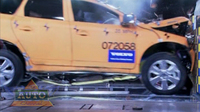Volvo Aims for Zero Accidents - VIDEO STORY
GOTHENBURG - July 18, 2008: At the Volvo Car Corporation, the vision is to design cars that should not crash. In the shorter perspective the aim is that by 2020 no-one should be killed or injured in a Volvo.
"We don't accept that people lose their lives in airplane accidents, so why should we regard car accidents as inevitable?" says Jan Ivarsson, head of Safety Strategy at the Volvo Car Corporation.
The World Health Organisation estimates that some 1.2 million people are killed and more than 50 million are wounded in traffic accidents every year. These figures are expected to rapidly increase if no action is taken. Volvo is determined to take lead by using its vision of a collision-free future as a guiding principle. "Continuous research and enhancement of safety in and around our cars will be essential for achieving a safer driver environment and a collision-free future. In this aim we invite fruitful cooperation with authorities and the automotive industry," Jan Ivarsson continues.
Click PLAY to watch video
The Volvo Cars Traffic Accident Research Team has investigated traffic accidents since 1970. Today its accident database contains information about more than 36,000 accidents. By using knowledge from real traffic situations in the research, Volvo has learned how to design cars that offer a very high level of safety in collisions. The company regards this as a very important base of knowledge when identifying high-tech solutions that can help to entirely avoid or mitigate accidents. In order to take this a step further the Traffic Accident Research Team not only studies crashed cars, it also investigates driving scenarios including driver behaviour in order to learn more about what can lead to hazardous traffic situations. "With more and more advanced technology, we design cars that help the driver avoid accidents and hopefully also avoid exposure to dangerous situations," says Jan Ivarsson.
To further address traffic incidents that might lead to accidents, Volvo has introduced a new strategy that includes a broader view of safety than the traditional focus on accidents. Even if the technology to design a collision-free traffic environment is not in place yet, the safety experts at Volvo says they know what they want to achieve.
They look into the driver's whole journey, from everyday driving to after a collision. The car's safety functions can be divided into five phases:
• Phase 1: Normal driving - Driver kept informed on driving status and driver concentration.• Phase 2: Conflict - Driver involved in a potentially hazardous situation, but able to cope with it.
• Phase 3: Avoidance - Driver less capable of coping with the situation.
• Phase 4: Damage reduction - Driver and car not capable of avoiding collision. Preparation for collision, reduction of crash forces.
• Phase 5: After collision - Driver offered assistance and rescue.
Volvo follows the principle that the driver should be in command. The "intelligence" of the car should support the driver, for instance by monitoring drowsiness or distraction. It can also warn the driver when the distance to other cars is too short. It is not until the driver fails to react and a collision is imminent or unavoidable, that the car "takes over" from the driver, for example by auto-braking. The lowered impact speed leads to less crash energy, which in turn increases the performance of the car's protective safety systems such as seat belts, airbags and crumple zones. In the near future Volvo plans to introduce safety technologies that make it possible to detect and auto-brake for pedestrians and even auto-steer away from oncoming cars.
With this new vision, Volvo Cars challenges not only itself but also the automotive industry and governments, since a collision-free future cannot be obtained by Volvo alone. Safe traffic has three main stakeholders: the car manufacturers, the drivers and the owners of the infrastructure (the relevant authorities).
Creative cooperation between road traffic authorities and other parts of the automotive industry is important in order to gain solutions that will have a big impact.
"There is considerable safety potential in creating communication between cars and infrastructure. Two cars could for example warn each other of queues or slippery roads. Infrastructure sensors could warn the driver of people or animals crossing the road," explains Jan Ivarsson. This requires that all cars speak the same "language" regardless of car brand, so international standards are needed.
The driver and passengers must understand the importance of following traffic rules and using the car's safety equipment.
"The three-point safety belt invented by Volvo was introduced as standard equipment nearly 50 years ago. At that time we believed it was so important to mankind that we offered the patent entirely free of charge to all manufacturers. It is still regarded as the most life-saving safety equipment in cars. Nevertheless, many people still do not use it. There is still a lot we can do to inform people about safety in cars of today," concludes Jan Ivarsson.
Today Volvo exports its safety knowledge to governments in other countries and they established a Traffic accident research centre in Thailand in 2003. The aim was to provide Thai officials with the basis for making the best decisions about the traffic situation in Thailand. Volvo, in turn, has gained greater knowledge about traffic environments in emerging markets and this information can be utilised in the development of future cars. Volvo recently signed an agreement to start up a similar project in China.



